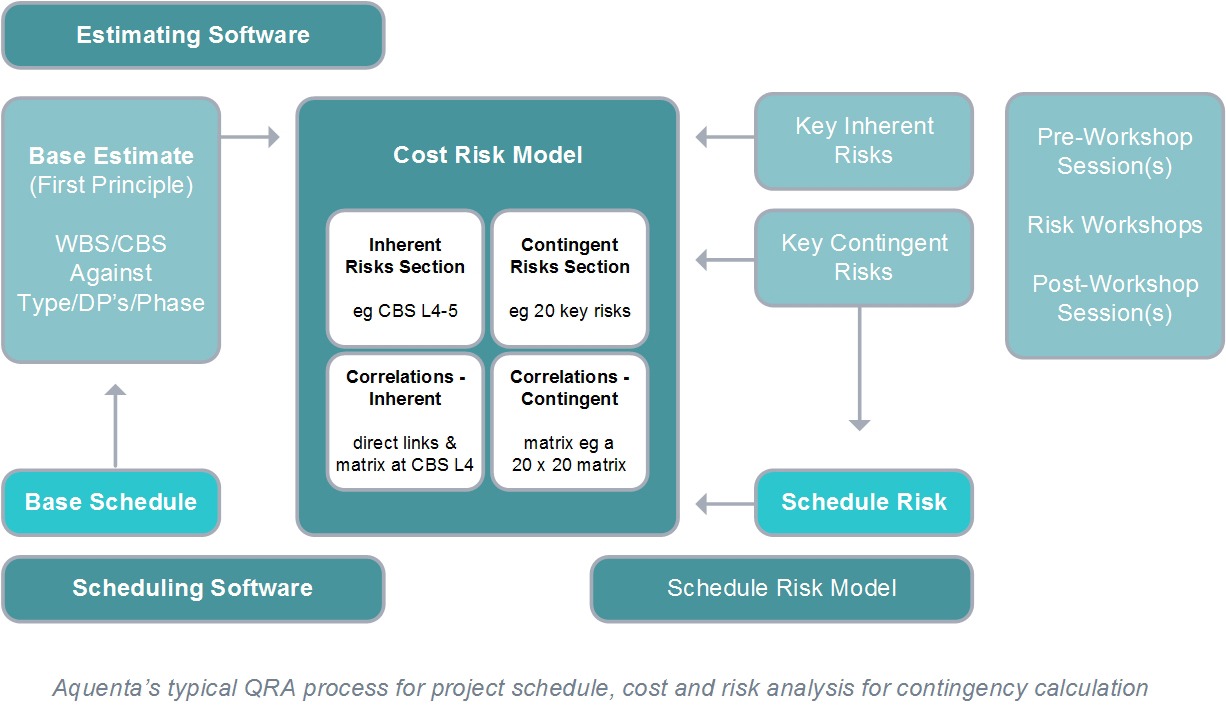
The team at Aquenta has over 60 years’ experience as a leading provider of integrated project services across key markets within the property and infrastructure space. Using a wide range of top risk analysis tools and platforms, including @RISK, they are able to conduct Quantitative Risk Analysis (QRA) for estimating appropriate levels of cost and schedule contingency allowances at different confidence levels on major projects. Aquenta has used @RISK for major projects including the Melbourne to Brisbane Inland Rail, the Melbourne Metro, the Sydney Metro Northwest, the Australia Pacific LNG Project (APLNG), and the Brisbane Underground Bus and Train (BaT) Tunnel.
“While many companies offer QRA services as part of their cost-estimating and scheduling arsenal, it can have varying degrees of effectiveness,” says Pedram Danesh-Mand, Technical Director of Risk Management Services for the Jacobs Buildings and Infrastructure business across the Asia-Pacific. “Our team applies a comprehensive risk assessment process supported by a number of robust risk analysis tools, including @RISK, to make the QRA process an integrated part of the project risk management to decision makers.”
Using @RISK, Aquenta harnesses industry best practices, including the Risk Engineering Society’s (RES) Contingency Guidelines, which clearly link assumptions made during the QRA process and its outcomes, and the Base Estimate, Base Schedule and the remedial actions required to address risks and opportunities identified during the QRA process.

Using @RISK
According to Danesh-Mand, “For quantitative risk analysis purposes, we use Palisade’s @RISK for two main applications: Cost Risk Analysis (CRA) and Schedule Risk Analysis (SRA),” he says. “Both methods capture the risks and uncertainties in project assumptions due to design maturity, interfaces, technical challenges, lack of qualified personnel, lower productivity rates and resource uncertainties to perform the work.”
SRA examines the effect of activities and events slipping on a project’s critical path through the Schedule Model. Using a similar approach, CRA examines the uncertainties and risk events to the project and specifies how they may affect the project costs.
“The main purpose of CRA is to capture uncertainty in cost estimate methodology, technical parameters, schedule uncertainty, and programmatic factors in order to move the deterministic point estimate to a probabilistic estimate,” Danesh-Mand adds. “In addition to inherent and contingent risks, the possible relationships and correlations between variables should also be identified and appropriately quantified within the model to ensure a reasonable and accurate contingency allowance is calculated.”
When using @RISK to run risk models, the Aquenta team typically uses two types of different distributions: continuous, and discrete distributions. “Common continuous distributions include the triangular, Pert, and uniform distributions,” Danesh-Mand explains. “The decision to use a particular distribution depends upon the nature of the risk being considered and other supporting data. For specific risk modelling (e.g. rain) with available statistical data, we will consider other continuous distributions if required.”
For Danesh-Mand and his team, the most commonly used discrete distribution is the binomial distribution – which returns either a single value or zero; depending on a percentage input to the formula. This can be used to model the likelihood of a contingent risk occurring.
Pedram Danesh-Mand
Technical Director of Risk Managment Services, Aquenta
“In the absence of good quality information, we use lognormal as the shape of the uncertainty distribution,” says Danesh-Mand. “If it is known that the distribution is left skewed, beta-PERT is recommended when there is no evidence to do otherwise.”
After running the simulations in @RISK, the resulting graphs show the Aquenta team identifying both a detailed and holistic view of the key risks and uncertainties associated with overall cost and schedule of the project, as well as the component parts of the project. They use a wide range of outputs, including probabilistic cash flow, tornado chart, contingency distribution chart and sensitivity analysis reports.
“Using these, we assess the overall probability that the project’s cost will be equal or less than the current approved budget,” says Danesh-Mand, “and we’ll also use it to determine if the project’s schedule (including all its interim milestones) will be equal or less than the current approved contractual completion dates.”
Benefits of @RISK
Aquenta’s overall project confidence level assessment process helps to not only inform management of the likelihood of a project’s programmatic success through combining the project’s cost, schedule and risk data into a complete picture, but also supports proactive risk mitigations to be selected for maximum values from risk management.
Danesh-Mand says that his favorite @RISK features is its wide range of distributions formulas and settings to model different possible scenarios, as well as its integration with other Palisade software, including DecisionTools. He also values the correlation matrix for addressing different possible relationships between key variables.
“In our experience, modelling correlations is far more important than the type of distribution.”
He also appreciates @RISK’s strong modelling capabilities for supporting an effective and efficient decision making process.
“At the end of the day, it’s not just about generating a contingency number, but to assist our clients in the identification, assessment and mitigation of risks, uncertainties and opportunities associated with their projects so we can make informed decisions.”
